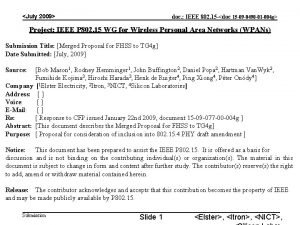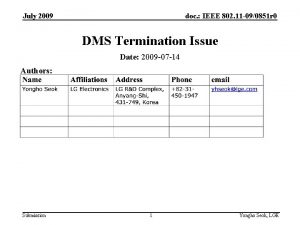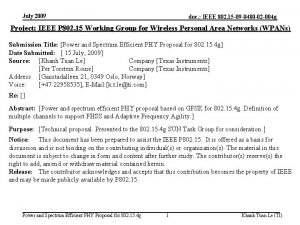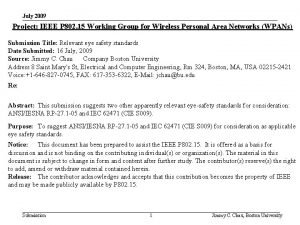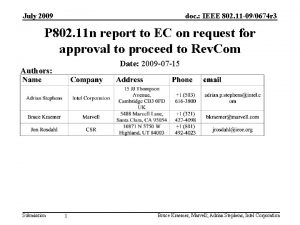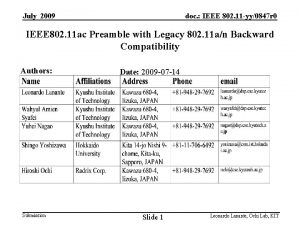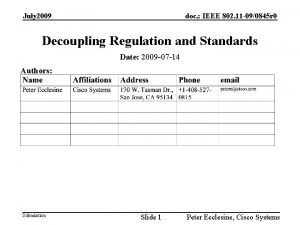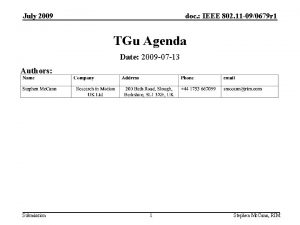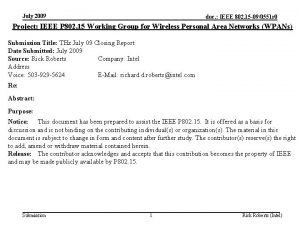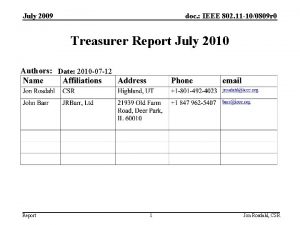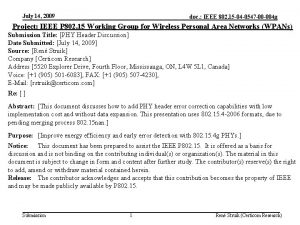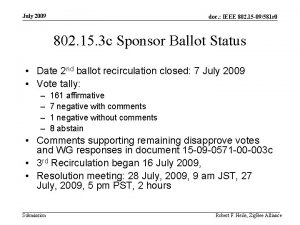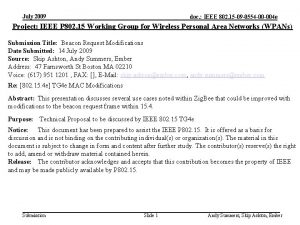6 July 2009 doc IEEE 802 15 09
















- Slides: 16

6 July, 2009 doc. : IEEE 802. 15 -09 -0486 -04 -004 g Project: IEEE P 802. 15 Working Group for Wireless Personal Area Networks (WPANs) Submission Title: FPP SUN Simulation Results – Redpine Signals Date Submitted: 6 July, 2009 Source: Partha Murali Company: Redpine Signals Inc. Address: 2107 N First Street, Suite #680, San Jose, USA Voice: +1 408 242 8506, E-Mail: partha. murali@redpinesignals. com Re: IEEE 802. 15 Task Group 4 g Call for Proposals (CFP) on 22 January, 2009 Abstract: This presentation summarizes the performance results of the “Future-Proof” OFDM PHY Merged proposal for Option-2 and Option-3 Purpose: Simulation Results demonstrating the performance of the Merged OFDM proposal for 802. 15. 4 g PHY Notice: This document has been prepared to assist the IEEE P 802. 15. It is offered as a basis for discussion and is not binding on the contributing individual(s) or organization(s). The material in this document is subject to change in form and content after further study. The contributor(s) reserve(s) the right to add, amend or withdraw material contained herein. Release: The contributor acknowledges and accepts that this contribution becomes the property of IEEE and may be made publicly available by P 802. 15. Submission Slide 1 Partha Murali, Redpine

6 July, 2009 doc. : IEEE 802. 15 -09 -0486 -04 -004 g Future Proof Platform for SUN: Simulation Results – Redpine Signals Partha Murali IEEE 802 Plenary Session San Francisco July 2009 Contributors: Rishi Mohindra [MAXIM], Emmanuel Monerie [Landis & Gyr], Steve Shearer [Independent], Shusaku Shimada [Yokogawa Electric Co. ], Bob Fishette [Trilliant], Sangsung Choi, [ETRI], Roberto Aiello [Independent], Kendall Smith [Aclara], David Howard [On-Ramp] Submission Slide 2 Partha Murali, Redpine

6 July, 2009 doc. : IEEE 802. 15 -09 -0486 -04 -004 g Outline • • Future Proof OFDM PHY overview of modes simulated Tx Model for Scalable OFDM PHY Channel Model Used Simulation Results - AWGN Simulation Results - Multipath Sensitivity and Link Margin Calculations Summary References Submission Slide 3 Partha Murali, Redpine

6 July, 2009 doc. : IEEE 802. 15 -09 -0486 -04 -004 g Future-Proof OFDM PHY – Modes simulated are highlighted OFDM OFDM Unit FFT size Active Tones # Pilots tones # Data Tones Approximate Signal BW BPSK 1/2 rate coded and 4 x repetition BPSK 1/2 rate coded and 2 x repetition BPSK 1/2 rate coded BPSK 3/4 rate coded QPSK 1/2 rate coded QPSK 3/4 rate coded 16 -QAM 1/2 rate coded 16 -QAM 3/4 rate coded Option 1 Option 2 Option 3 Option 4 Option 5 128 64 32 16 8 108 52 26 14 6 8 4 4 2 2 100 48 22 12 4 1064 518 264 146 68 k. Hz kbps 98 kbps 195 94 43 391 187 86 47 kbps 586 281 129 70 kbps 781 375 172 94 kbps 562 258 141 47 kbps 750 344 187 62 kbps 516 281 94 kbps • For details on the proposed OFDM-PHY please refer to 15 -09 -0489 -01 -004 g-FPP-SUN-Detailed-Proposal. doc Submission Slide 4 Partha Murali, Redpine

6 July, 2009 doc. : IEEE 802. 15 -09 -0486 -04 -004 g Tx Model for Scalable OFDM PHY Submission Slide 5 Partha Murali, Redpine

6 July, 2009 doc. : IEEE 802. 15 -09 -0486 -04 -004 g Multipath Channel Model used SUN Multipath Channels Average Tap Channel relative Tap Relative Sampling Tap Sample power Channel Type Number Delay (us) Rate (KHz) Number (d. B) Typical Urban Bad Urban Hilly Terrain Submission 1 0 3125 0 0 amp 1 2 5 3125 16 -22. 3 amp 2 1 0 3125 0 0 amp 1 2 5 3125 16 -3 amp 2 1 0 3125 0 0 amp 1 2 15 3125 47 -8. 6 amp 2 Slide 6 Partha Murali, Redpine

6 July, 2009 doc. : IEEE 802. 15 -09 -0486 -04 -004 g Multipath Channel Matlab Code (for Reference) function [y]=two_ray_multipath_channel(x, amp 1, amp 2, n_Fs. Delay) % x is the input to the Multipath channel % y is the output of the Multipath channel %amp 1 = Average amplitude of 1'st path in d. B %amp 2 = Average amplitude of 2'nd path in d. B %n_Fs. Delay = Delay in Number of Samples at the sampling rate of x. % If x is sampled at 3125 KHz (5 x) and n_Fs. Delay=16 then sample delay of second tap is 5 us. RV 1=(randn(1, 1)+j*randn(1, 1))/sqrt(2)*10^(amp 1/20); RV 2=(randn(1, 1)+j*randn(1, 1))/sqrt(2)*10^(amp 2/20); y=(x*RV 1 + [zeros(1, n_Fs. Delay) x(1: (length(x)-n_Fs. Delay))]*RV 2)/sqrt(10^(amp 1/20) + 10^(amp 2/20)); Submission Slide 7 Partha Murali, Redpine

6 July, 2009 doc. : IEEE 802. 15 -09 -0486 -04 -004 g Notes on Simulation • Channel Models used are from: ETSI EN 300 392 -2 v 3. 2. 1 which are chosen for SUN simulations • Channel was Sampled at 5 x sampling rate of signal (625 Khz * 5 = 3125 Khz) • The Multipath Fading channel output should “not” be normalized for each packet. The Multipath Fading channel has “unit-normalized” gain in the “ensemble” sense over multiple packets. • All PER plots are with respect to Ensemble SNR (d. B) = Tx Signal Power – Path. Loss – 20*log 10(k*T*B). • SNR at Receiver input was varied by varying the Path Loss • 500 channel realizations were simulated for each Path loss (each SNR point) to estimate the PER at that SNR Submission Slide 8 Partha Murali, Redpine

6 July, 2009 doc. : IEEE 802. 15 -09 -0486 -04 -004 g Simulation Results: AWGN – Summary Future Proof OFDM Proposal Option-2 In-Band Thermal Noise Floor k*T*B (d. Bm) Approximat assuming Sampling e Signal 625 KHz Noise FFT Rate Bandwidth bandwidth Points 625 KHz 518 KHz -116 64 Data- AWGN Modula Code Rate 10 Byte 100 Byt 1 KByte tion Rate (Kbps) (d. B) e (d. B) 16 -QAM 1/2 750 8 9. 5 10. 5 QPSK 3/4 562. 5 5. 5 6. 5 7. 4 QPSK 1/2 375 3 4. 1 4. 9 BPSK 1/2 187. 5 1. 8 Notes 1 2 Submission Receiver Used had an implementation loss of <0. 5 d. B The numbers in green are the SNRs for 1% Packet Error Rate Slide 9 Partha Murali, Redpine

6 July, 2009 doc. : IEEE 802. 15 -09 -0486 -04 -004 g Simulation Results: AWGN – Summary Future Proof OFDM Proposal Option-3 In-Band Thermal Noise Floor k*T*B (d. Bm) Approximat assuming Data- AWGN Sampling e Signal FFT Modula Code Rate 10 Byte 100 Byt 1 KByte 312. 5 KHz Rate Bandwidth Noise BW Points tion Rate (Kbps) (d. B) e (d. B) 312. 5 KHz 264 KHz -119 32 16 -QAM 3/4 516 11. 6 13. 3 14. 2 312. 5 KHz 264 KHz -119 32 16 -QAM 1/2 344 7. 9 9. 3 10. 2 312. 5 KHz 264 KHz -119 32 QPSK 3/4 258 5. 5 6. 3 7. 1 312. 5 KHz 264 KHz -119 32 QPSK 1/2 172 2. 9 4 4. 7 312. 5 KHz 264 KHz -119 32 BPSK 1/2 86 1. 4 1. 5 1. 8 Notes 1 2 Submission Receiver Used had an implementation loss of <0. 5 d. B The numbers in green are the SNRs for 1% Packet Error Rate Slide 10 Partha Murali, Redpine

6 July, 2009 Submission doc. : IEEE 802. 15 -09 -0486 -04 -004 g Slide 11 Partha Murali, Redpine

6 July, 2009 doc. : IEEE 802. 15 -09 -0486 -04 -004 g Simulation Results: Multipath – Summary Sampling Rate 625 KHz In-Band Thermal Noise Floor Typical Bad Hilly k*T*B (d. Bm) Approximat assuming FFT Data- Urban Terrain e Signal 625 KHz Poin Modulati Code Rate 100 Byte Bandwidth Noise BW ts on Rate (Kbps) (d. B) 518 KHz -116 64 16 -QAM 1/2 750 19 18. 6 18 518 KHz -116 64 QPSK 3/4 562. 5 16. 4 17. 5 19 518 KHz -116 64 QPSK 1/2 375 13 9 10. 4 518 KHz -116 64 BPSK 1/2 187. 5 8. 5 7 8 Notes 1 Receiver Used had an implementation loss of <0. 5 d. B 2 The numbers in green are the SNRs for 10% Packet Error Rate Submission Slide 12 Partha Murali, Redpine

6 July, 2009 Submission doc. : IEEE 802. 15 -09 -0486 -04 -004 g Slide 13 Partha Murali, Redpine

6 July, 2009 doc. : IEEE 802. 15 -09 -0486 -04 -004 g Sensitivity and Link Budget Calculations (Bandwidth Option-2) Option-2 1 KByte, 16 -QAM BPSK ½, ½, 187. 5 Kbps 750 Kbps Mode Transmit Power (example) 30 d. Bm Transmit & Receive Antenna Gains (combined) Fading Channel Model 30 d. Bm 0 d. Bi No Fading Bad Urban (AWGN) Fading Required Rx SNR 1. 8 7 18. 6 In-band Noise Floor k*T*B (d. Bm) -116 RF Transceiver Noise Figure (including RF Front-end) (d. B) 4 4 4 Digital Implementation Loss (d. B) Receive Sensitivity at Antenna for 187. 5 Kbps Mode (d. Bm) 1 1 1 -109. 2 -104 -92. 4 “REAL” Link Margin (d. B) 139. 2 134 122. 4 Submission Slide 14 Partha Murali, Redpine

6 July, 2009 doc. : IEEE 802. 15 -09 -0486 -04 -004 g Summary, Conclusions and Discussion • • “Multipath Fade Margin” Reduces Considerably with BICM (Bit-Interleaved Coded Modulation) OFDM Systems – The difference in performance between AWGN and Fading results is about 7 d. B for Option-2 – Dummy repeater nodes would be minimal in most deployments (even suburban & rural) => easy to approach 100% regional coverage for AMI & Smart-grid – Excess link-margin can be traded OFF for lesser Tx Power (simpler PA => low-cost, low-power) Future-Proof OFDM provides scalable bandwidth Options – Fits all regulatory domains – 1 x, 2 x, 4 x, 8 x and 16 x bandwidth options – Bandwidth options 2 and 3 are simulated in this document Future-Proof OFDM provides scalable data-rates in each bandwidth option – 94 -750 Kbps for Option-2 (>15 d. B range in SNR of operation) – 43 -516 Kbps for Option-3 (>20 d. B range in SNR of operation) All the above is achieved in a coherent fashion with a simple symbol structure to enable single chipset implementations for multiple bandwidth options Submission Slide 15 Partha Murali, Redpine

6 July, 2009 doc. : IEEE 802. 15 -09 -0486 -04 -004 g THANK YOU Submission Slide 16 Partha Murali, Redpine
 Bridges from 802.x to 802.y
Bridges from 802.x to 802.y Bridges from 802.x to 802.y
Bridges from 802.x to 802.y July 30 2009 nasa
July 30 2009 nasa Ieee 802 3 compliance
Ieee 802 3 compliance Wlan standards
Wlan standards Arquitetura ieee 802
Arquitetura ieee 802 Modelo ieee 802
Modelo ieee 802 Ieee 802 standard
Ieee 802 standard Ieee 802 bluetooth
Ieee 802 bluetooth 802 ieee
802 ieee Ieee 802
Ieee 802 Ieee 802 family
Ieee 802 family 2001 july 15
2001 july 15 July 14 1789
July 14 1789 Monday 13th july
Monday 13th july June too soon july stand by
June too soon july stand by Sylvia plath poppies in july
Sylvia plath poppies in july

















